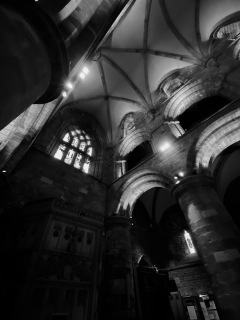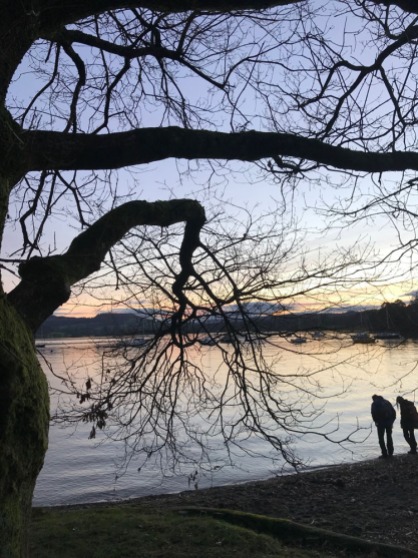
“It’s as though… there’s something wrong with the horizon…”
Barbara was speaking softly, giving voice to one of the defining thoughts of the day. Something wrong with the horizon, how true. Craster’s harbour was disappearing behind us, but the cut-up horizon was still far away. There is no other way to reach Dunstanburgh Castle than on foot; though, back in history, distinguished visitors could arrive by sea – into it’s private harbour – as well. You had to be very wealthy to build a castle with its own private harbour, and the Earl of Lancaster was very wealthy. He was cousin to the King, Henry II, but, more significantly, he was the nephew of a man he considered to have been a much greater king – Henry I.

The dark, jagged vision grows as we walk. Back in the winter, when Bernie and I had come this way to explore the possible sites for the weekend, I could find no words to express that distant starkness. Now, one of the Companions did: “It’s as though it was deliberately punished, in such a visible way that no-one could ever forget…” History shows that, actually, it wasn’t. The ravages of time, neglect and a life on a Northumbrian cliff did that. But, emotionally, it looks exactly like a ‘punished place’, and that serves our ‘psychological’ purpose, here. The nature of the illusion lies in the mystery of the shapes used in its architecture…

Emotions are important on this, Day 2 of the Castles of the Mind weekend. We are hunting them, and encouraging them when they arise, naturally, like on this long walk over the headland. Emotions may not be as reliable as the more mundane reason, but they manifest immediately, and, if we learn their language, and know when to combine them with the mind’s discrimination, we can get much closer to the ‘soul’ – the essence of ourselves, using their energy. The external natural essence we’re tapping into in the land at Dunstanburgh is a strange one… beauty and the beast, almost.

Here, we have to have a little history to appreciate what we’re looking at; for the jagged horizon takes us back to the later years of the Medieval era, a time of battle and romance – or so the popular view suggests. 1313 is the date on which work on Dunstanburgh Castle began – just one year after the unholy alliance of the French king and the Pope ‘dissolved’ the Knights Templar.

It is hard to imagine taking a landscape so beautiful and ending up with a place scarred in such a lasting way. Yet, Dunstanburgh Castle is just that – at least emotionally. And that was what swung it into the short list of places for our weekend; what could be visited in the few short days that a Silent Eye weekend has available to it. There’s nothing logical about declaring that we are ‘pilgrims of the heart and mind’ travelling between the splendour of Bamburgh and the noble simplicity of Lindisfarne – and then making a detour fifteen miles south…
But once we had seen it on that dark horizon, it had to be part of the itinerary. It had to follow Bamburgh Castle because a human existence energised and brought back to ‘life’ by examination and a restless dissatisfaction with ordinary living must face up to a critical stage before it can move on.
The spectre growing in the near distance was the best example we had ever met of the word ‘ruin’. You don’t need to see your life as a ruin to make life-enhancing changes to it. What has been hard-won in life can serve what follows without destruction, only the captain of the ship needs to change. Yet, as Shakespeare understood so well, to tell a story that involves ruin challenges us to examine ourselves; in ruin lies a compelling set of emotions; emotions that energise change.

‘There was a powerful man who had a favourite nephew’. It could be the opening to one of the Bard’s plays, but, instead, it’s our own history – part of the story of how the English came to be. The powerful man was King Edward I; the young nephew became Thomas, earl of Lancaster, and he built Dunstanburgh Castle. It may seem odd for the powerful house of Lancaster to have estates so far away from the north-west, but it was normal for the Lancaster and York houses to have far-flung estates, in places of military importance. Both were, essentially, southern-based houses of power and the Wars of the Roses were yet to start, though they were not far away in time.
The Earl of Lancaster seems to have been an accomplished but arrogant man. He inherited the barony of Embleton from his father; Edmund ‘Crouchback’, who was the younger brother of King Edward I. King Edward was a major castle-builder, and created many of the spectacular castles that we visit in Wales, today. Previous lords of Embleton included the famous rebel Simon de Montfort, earl of Leicester, on whose life Lancaster may well have modelled his own.
Another, and more negative force forged Thomas, earl of Lancaster’s life: he hated his cousin the King, Edward II.

King Edward II was homosexual. His outspoken lover, Piers Gaveston, was despised by the barons, who plotted to ambush and kill him. The picture, above, photographed from the English Heritage guide book, shows the presentation of his head to the earls of Warwick, Lancaster (centre) and Hereford in 1312.
Edward bided his time in exacting his revenge. Cooler-thinking that the hothead Lancaster, he initially pardoned the earls who had kidnapped and murdered his lover (on Lancaster land). But history showed he was awaiting his opportunity.
With an eye on his own future security, Thomas decided that he would do something with the property he had inherited near Embleton, and he began work on Dunstanburgh, work that included the construction of not only one of the most ambitious castles of its day, but freshwater lakes surrounding it, and a stone harbour that brought important visitors and guests face to face with the twin stone towers, modelled on those used in his uncle’s Welsh masterpieces – a style lacking in anything build by his cousin, the King.

I hadn’t noticed it on our preparatory visit, but, facing it now with the knowledge of why it was constructed, it was such an obvious statement of intent…
Thomas, earl of Lancaster, was beheaded by the sword in 1322, after mounting a further unsuccessful rebellion against his patient king. His retreat to the finished castle at Dunstanburgh – designed to withstand any siege – was cut off by a party of the King’s troops. Lancaster was later unofficially venerated as a victim of royal murder, like his namesake St Thomas Becket.

We were all strangely silent in the interior of Dunstanburgh. Lost, probably, in our own histories and their triumphs and disasters…
It had been a long day, already, but, prior to a well-earned dinner in a country pub, we had a final surprise in store for the Companion pilgrims…
To be continued.
©️Stephen Tanham
Other parts of this series:
Part One, Part Two, Part Three,
Stephen Tanham is a director of the Silent Eye School of Consciousness, a not-for-profit organisation that helps people find a personal path to a deeper place within their internal and external lives.
The Silent Eye provides home-based, practical courses which are low-cost and personally supervised. The course materials and corresponding supervision are provided month by month without further commitment.
Steve’s personal blog, Sun in Gemini, is at stevetanham.wordpress.com.
You’ll find friends, poetry, literature and photography there…and some great guest posts on related topics.




























I usually like ruins, but these look unnervingly as though they have been eaten!
LikeLiked by 1 person
So true, Jaye. A haunting outline!
LikeLiked by 1 person
Reblogged this on The Silent Eye.
LikeLike
The photographs are stunning, Steve! One would feel as though they are right there with all of you. And thank you for the elucidating history lesson!
Jordis
LikeLiked by 1 person
Thank you, Jordis. Fun to write, too. Brings it all back x
LikeLiked by 1 person
Pingback: The Stone and the Pilgrim (5) – The Silent Eye
Pingback: The Stone and the Pilgrim (5) | Sun in Gemini
Pingback: The Stone and the Pilgrim (6) final part | Sun in Gemini
Pingback: The Stone and the Pilgrim (6) final part – The Silent Eye